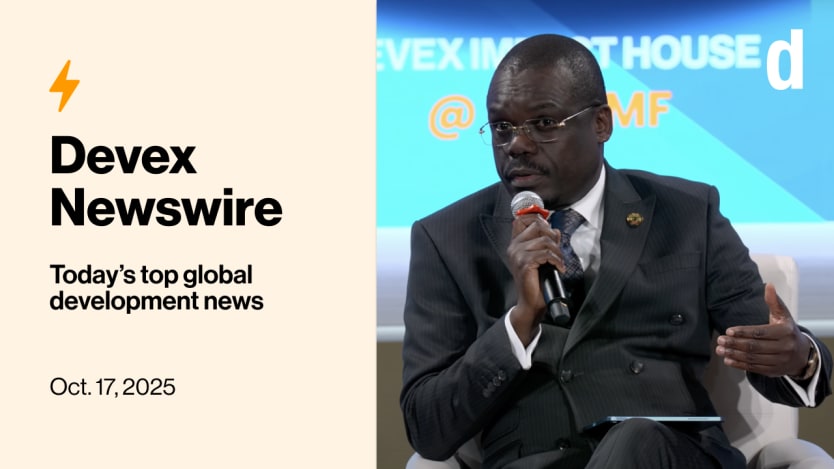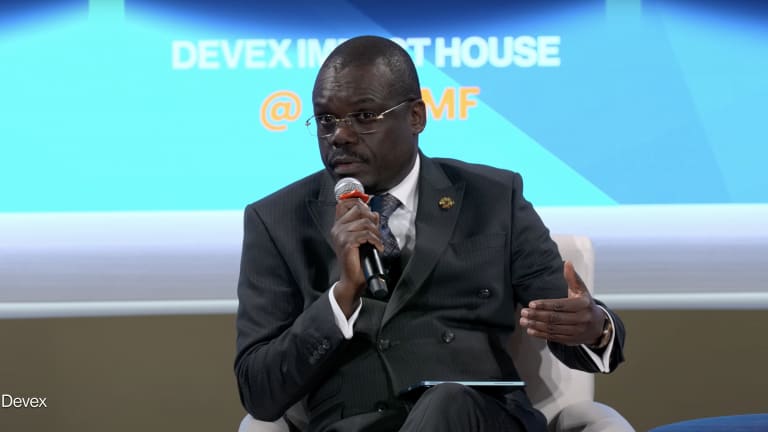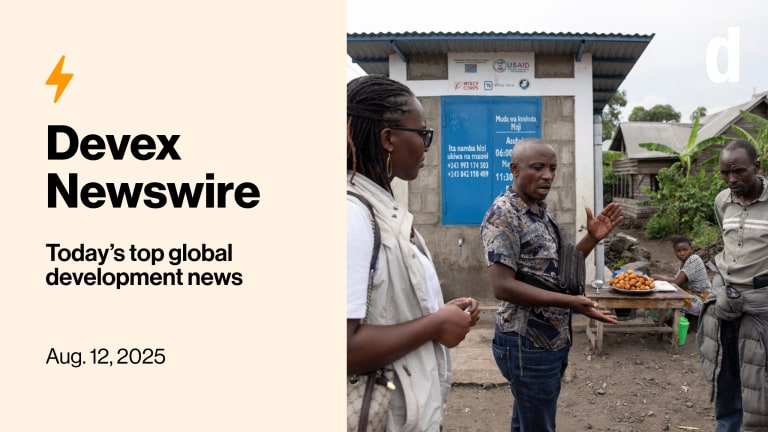Presented by The Bristol Myers Squibb Foundation

Sixty percent of traditional foreign health aid to Africa was effectively wasted — that’s the bombshell Africa CDC’s Jean Kaseya dropped in Washington this week.
Also in today’s edition: Axel van Trotsenburg, senior managing director at the World Bank, warns that donors won’t just write checks anymore.
+ Happening on Monday: As the World Bank-IMF meetings wind down this week, how can job seekers successfully get into these institutions? To answer this, we’re bringing a former World Bank HR specialist to give insights on how to stand out when applying to multilateral agencies. Register now to join us.
More value with less money
What if Africa’s health systems don't actually need more aid — just smarter aid?
That’s the argument Africa Centres for Disease Control and Prevention Director-General Jean Kaseya made as he challenged the logic of a system that for decades poured billions into Africa’s health programs without always building government capacity or coordination to sustain them.
“We don’t need more than 40% of [the] money we were receiving before,” Kaseya told Devex President and Editor-in-Chief Raj Kumar during a Devex Impact House event on the sidelines of the World Bank and International Monetary Fund annual meetings in Washington, D.C. He argued that what’s required now is efficiency, not more funding.
Former Ethiopian Health Minister Lia Tadesse Gebremedhin agreed, saying that with fragmentation and duplication, sometimes inefficiencies could reach up to 80%. Both made the case that the sharp decline in foreign aid could be the wake-up call the continent needs.
Kaseya said the key to ensuring there is more value with less money now that foreign aid has sharply decreased is for countries to create integrated national health plans that outline how much health care programming costs and for donors to align under that plan. Those plans, he added, should be accompanied by strong national governance, the continental use of pooled procurement of health products to drive down costs, and the elimination of fraud.
He added that global partners must also coordinate with one another so countries aren’t burdened with and confused by multiple sets of requirements to receive funding and for donors to give countries a clear understanding of how long they will provide support — so governments have predictability in how they run programs.
External funding should work to enhance national public systems, Tadesse Gebremedhin said, adding that while foreign aid cuts may be initially painful since there wasn’t much of a transition plan to soften the blow, she also sees this as a moment of opportunity.
This is in line with the “Accra Reset” — an effort led by Ghanaian President John Dramani Mahama which aims to use this disruption to chart a new course toward health sovereignty, where national ownership takes center stage and global cooperation becomes more balanced and equitable.
Read: 60% of foreign health aid was effectively wasted, says Africa CDC chief
ICYMI: The ‘Accra Reset’ — time’s up for the legacy aid system
Related: Global health expert blasts aid addiction and dysfunctional system (Pro)
+ Not yet a Devex Pro member? Start your 15-day free trial today to access all our exclusive reporting and analyses, data-driven funding insights, members-only events and briefings with sector leaders, and the Pro Insider — a weekend newsletter that gives you a weekly head start on our industry’s big moves.
Accountability, jobs, and trust
The World Bank’s fund for low-income countries survived the Trump-era cuts, but for Axel van Trotsenburg, the bank’s senior managing director, its future hinges on outcomes, transparency, and listening.
“I think the fact that there is the call for more accountability, there is the call for outcome orientation, I think is fair,” he told Raj during a Devex Impact House session. His warning: Donors won’t just write checks anymore.
He blames the aid crisis on fiscal pressures and “disillusionment about [aid effectiveness].” The fix? What he calls “the art in working in a multilateral institution” — building consensus and showing real value.
On debt, he’s pushing “radical transparency.”
“Just say what you want to use it for, explain from whom you borrowed, what are the terms … and let the local politicians and also [the] press or NGOs think, then debate whether it is desirable.” Without openness, debt becomes “a boomerang.”
On climate, it’s about framing: “We always say climate cobenefits, and that was a joint definition with the other multilateral development banks.” That approach helped 48% of the bank’s commitments carry climate cobenefits last year.
And under World Bank President Ajay Banga, jobs are the unifying goal. “There are huge challenges in order to basically give young people a perspective, a life, a dignity, a future,” van Trotsenburg said. “This is very often done also through a job that is fulfilling.”
Read: Axel van Trotsenburg on what it will take for multilateralism to survive
ICYMI: For World Bank President Ajay Banga, all roads lead to jobs
+ Listen: For the latest episode of our podcast series, recorded live on the sidelines of the World Bank-IMF annual meetings in Washington, my colleagues Adva Saldinger, Michael Igoe, and Elissa Miolene discuss what’s at stake at meetings.
Private capital fatigue
The grand vision of “billions to trillions” in private capital for development hasn’t lived up to the hype. Panelists from Citi, the Gates Foundation, and the World Bank were blunt: Structural barriers and regulatory hurdles still stand in the way.
“There’s so much fatigue around private capital mobilization,” said Stephanie von Friedeburg, managing director and global head of public sector at Citi. “I think we have to go back to the basics. We have to crawl, we have to walk, and then we have to run.”
She pointed to five persistent obstacles: too few bankable projects, currency risk, weak enabling environments, limited data, and regulation. “Until we make some surgical changes to [the Basel Committee on Banking Supervision’s international regulations] and ultimately to U.S. regulation, the money won’t move.”
Kalpana Kochhar, director of development policy and finance at the Gates Foundation, agreed private money isn’t the answer everywhere. “Private money doesn’t — and maybe even shouldn’t — go to certain sectors,” she said. “We have to ring-fence grant money for low-income countries and sectors where returns are societal and long-term.”
For Guangzhe Chen, World Bank’s vice president for infrastructure, the priority is leverage: “Whatever capital we have is far from sufficient … so whatever we do, we have to think about how much we can leverage.” The bank is embedding that logic across projects, aiming for a 1-to-5 ratio, with early coordination between the International Finance Corporation and the Multilateral Investment Guarantee Agency.
Read: ‘Billions to trillions’ fatigue sets in among top finance leaders
ICYMI: How is the private sector thinking about development? (Pro)
+ Check out all the on-the-ground coverage by our team tracking the stories that matter from the World Bank-IMF meetings this week in Washington, D.C., and stay tuned for a special wrap-up newsletter that will hit your inbox on Monday.
From promise to action
The Fund for Responding to Loss and Damage will allocate $250 million in grants to support projects in vulnerable developing countries that have suffered from climate-related loss and damage. Grants will range from $5 million to $20 million per intervention, with applications opening on Dec. 1 for a six-month window. The call for funding requests — dubbed the Barbados Implementation Modalities, or BIM — will focus on country-led, bottom-up approaches to ensure resources reach communities most affected by climate impacts.
The announcement marks the operationalization of the fund, which has been in the wings of climate action since it was initially launched at the 27th United Nations Framework Convention on Climate Change, or COP27, in 2022. While the fund had made some key decisions in the past, such as appointing its executive director, this move is the first indication of how the fund will take action in developing countries moving forward.
Related opinion: Progress on loss and damage fund shows climate is global priority
Pathways for migration
High-income countries face a “massive aging problem,” and Lant Pritchett, research director at Labor Mobility Partnerships, said the fix is clear: Create legal, orderly pathways for workers from lower-income countries.
“From a development point of view, helping … developing countries become effective suppliers to [the labor] needs [in high-income countries] is a really super important development activity,” he said. That means being “more effective at recruiting, preparing, placing, protecting and returning workers,” plus certification programs employers actually trust.
The payoff? Productivity is place-based. Moving from a low-income to a high-income country can boost wages fivefold, compared to the 10% bump from in-country development programs. For Pritchett, labor mobility is “one of the most effective poverty reduction tools available.”
On the ground, Maryland in the United States shows what’s possible. With 20% of its workforce foreign-born, the state helps refugees write résumés, recognizes foreign degrees, and ensures immigrants feel safe accessing schools and health care. “We have to focus on reality,” said Kamal Essaheb, director of immigrant affairs in the office of the governor of Maryland. “We have to focus on the specific conditions on the ground.”
Both speakers dismissed the idea that immigrants take jobs from locals. As Pritchett put it, economists have “done the world a disservice” by sticking to “growing the pie” metaphors. “You need croissants and you need bread.”
Essaheb summed it up: “There are solutions here that are mutually beneficial.”
Read: Think of jobs as an industry to develop, labor expert advises
From ideas to projects
With aid budgets shrinking and climate disasters mounting, development finance leaders are rethinking how to protect vulnerable communities before crises hit.
For Hope Murera, CEO of reinsurer Zep-Re, the answer is reshaping insurance to meet Africa’s realities. “Reinsurance is global. Insurance is global. But what are the real realities on the ground that we need to solve for?” she asked. Her focus: smallholder farmers, women, and SMEs — the groups most exposed to risk. “When we have disasters, 95% of those are uninsured.”
Zep-Re is linking insurance to credit. Its DRIVE initiative has paired drought coverage with financial services in the Horn of Africa, opening 500,000 bank accounts for previously unbanked pastoralists. “Credit and insurance are merging,” Murera said. “We de-risk them so that they can access credit and be in a bracket that is productive.”
From the lending side, Serge Ekué, president of the West African Development Bank, said his institution aims to blend local insight with global ambition. “We are a bank that is small enough to care ... but big enough to deliver.” Its Shock Resilience Loan Program uses parametric insurance to trigger rapid support after floods or droughts, while its “originate-to-distribute” model helps turn local ideas into viable, bankable projects.
Because in the end, as Ekué put it: “An idea is an idea, an idea is not a project.”
Read: These African financiers are closing the gap between risk and resilience
In other news
Conflict has pushed around 63 million children into hunger this year, more than half of the 118 million children facing starvation worldwide. [Save the Children]
France and Britain, in coordination with the United States, are working to finalize a U.N. Security Council resolution in the coming days that would lay the foundation for a future international force in Gaza. [Reuters]
The controversial U.S. and Israeli-backed Gaza Humanitarian Foundation has confirmed it suspended operations in Gaza after the ceasefire deal between Israel and Hamas came into effect on Oct. 10, despite being funded until November. [BBC]
Sign up to Newswire for an inside look at the biggest stories in global development.








